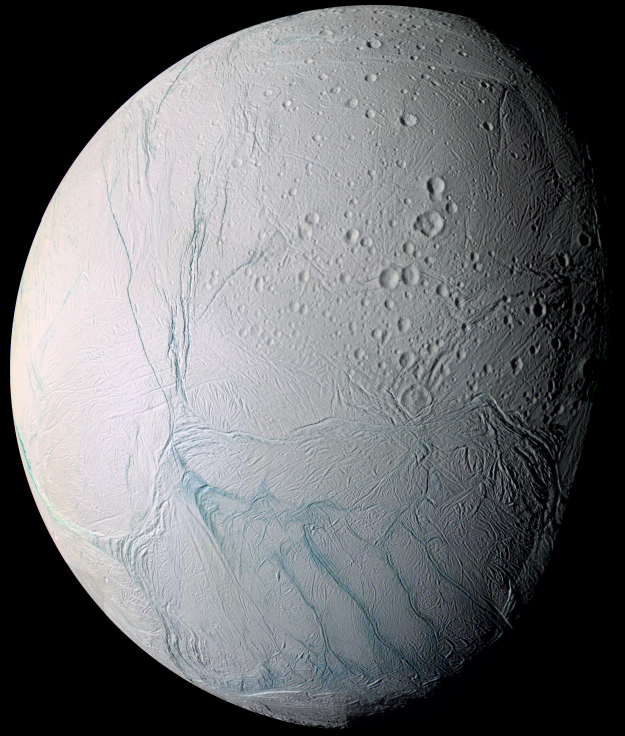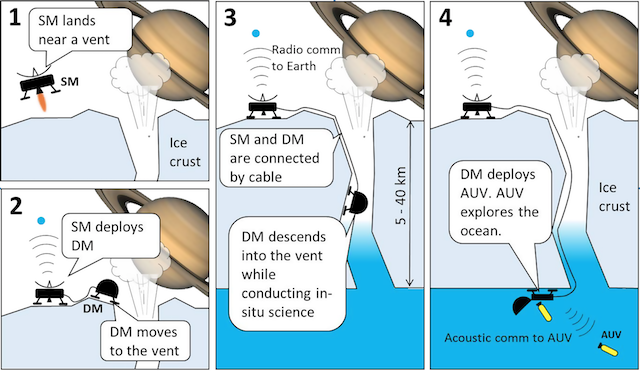European Space Agency: the surface of Enceladus warms up from the inside

Fragment of a picture of the surface of Enceladus
Over the past few decades, during which scientists have studied the solar system, we managed to find out that conditions on many planets and satellites are more favorable for living organisms than previously thought. In particular, liquid water and water ice were found on Mars, Europe, Enceladus and a number of other planets and planetoids. The Cassini probe repeatedly flew past Enceladus, the satellite of Saturn. It turned out that there are regular eruptions of cryovolcanoes, when liquid water, steam and water ice, breaking through the thick ice crust, flies under pressure to great heights.
At Enceladus, according to astronomers from NASA and ESA, there is a high probability of a warm subglacial ocean. One of the confirmations is the cryovolcanoes, the eruption of which even Voyager took off at one time. Now ESA experts have found another important point. It turns out that the ice crust of Enceladus is warming from the inside, and already a few meters from the surface is a few degrees warmer than it was believed. So far, scientists have proved the heating of Enceladus bark on the South Pole.
For the first time, astronomers obtained evidence of the existence of cryovolcanoes on Enceladus in 2005, when Cassini transmitted pictures of Saturn’s satellite to Earth. Fountains of water vapor and ice beat from the cracks in the ice shell of the satellite of Saturn regularly.
')

In 2005, Cassini received high-resolution images of Enceladus. After analyzing the images, it became clear that the ice crust is covered with cracks and craters. This image was obtained by combining 21 photographs of Enceladus. Colors are not true
Cassini repeatedly flew past Enceladus, as a result of which experts were able to collect a large amount of data about this object, including photographs and measurement results of scientific instruments of the probe. After a detailed study of images with cryovolcanes, it became clear that under the surface of the satellite of Saturn, most likely, there is a warm ocean of liquid water.

The oscillations of the planetoid in orbit were considered indirect evidence of this. It turned out that the amplitude of these oscillations is greater than if Enceladus was completely solid.
The amount of data sent by Cassini is huge, they are still being studied and analyzed. At the end of the past and the beginning of this year, astronomers from ESA started analyzing the data obtained during the study of Enceladus using microwave radiation. The "fingerprint" of Saturn's satellite in the microwave range was received in 2011, when Cassini flew over Enceladus's south pole. “In the course of this rapprochement, we obtained the first, and, unfortunately, the latest data on the South Pole of Enceladus obtained using microwaves,” said Alice Le Gall, a member of the Cassini mission from the University of Versailles-Saint-Quentin-en -Ivelin. To work in the microwave range on the Cassini installed tool RADAR .
“Observations of this type made it possible to understand what is happening below the surface. The results of the study of the obtained information show that the first few meters of subsurface ice are much warmer than we could expect, ”says Le Gall. - "These data can not be explained only by the radiation of the sun or heating from the side of Saturn, there must be an additional source of heat."
Perhaps the source of heat is the geological activity of Enceladus. Only not the ice crust, but already the mantle and the true crust. Scientists already know that in the past, Enceladus had large-scale geological events. Most likely, the hidden activity of this type is now.
Despite the fact that data were obtained only on a small portion of the surface of the South Pole, there is reason to believe that the entire pole is warming from below. Most likely, experts say, the ocean is splashing under the ice with a thickness of 2 kilometers. These assumptions are quite consistent with the results of another study on the determination of the thickness of ice crust on Enceladus. According to Odrej Cadek, who published a scientific paper on Enceladus last year, the thickness of the ice on the satellite of Saturn is about 18-22 km. But at the South Pole ice thickness decreases to less than 5 km.
According to Kadek's colleagues, the heating of Enceladus is carried out by an under-ice source / sources of heat, whose activity is associated with tidal cycles of the planetoid. Probably, the ebb and flow caused by a change in the gravitational effect of Saturn as Enceladus moves in orbit leads to a deformation of the planetoid cortex.
Accordingly, if the crust of the satellite of Saturn is thinner than was thought, and the temperature under the ice is higher, this increases the chances for the existence of life there even more. “These results open up new perspectives in the study of the extreme conditions of life on the ice moons of the gas giants,” says Nicholas Altobelli, an ESA specialist. “If Enceladus’s subglacial sea is really as close to the surface as the results of the study show, then in the future it will be possible to plan a mission to launch an subglacial probe that can find this sea.”
The concept of such a probe is being developed by NASA as part of the NASA Innovative Advanced Concepts Program (NIAC). True, the most promising is now considered to be the study of Europe, the satellite of Jupiter. But, perhaps, after the scientists received new data on Enceladus, priorities will shift.

This is how the process of penetration of a probe under the ice of Europe or Enceladus may look like (image: NASA / JPL-Caltech)
One of the possible ways of penetration of the probe under the multi-kilometer thickness of ice is the search for a cryovolcano vent with subsequent descent through this opening to the liquid water. The first is Icy-Moon Cryovolcano Explorer (ICE), a robotic station that releases a special probe for walking on the mouth of a cryovolcano. This probe, going down the wall of the vent, gets to the water, where another apparatus drops, this time underwater. And already the submarine begins to explore the subglacial ocean, sending information about its findings to the first probe, and he sends information to the station. The station sends the collected data to Earth.
Source: https://habr.com/ru/post/402361/
All Articles